Teaching translation modules using moodle: A quantitative research at university of foreign languages, Hue university
he advancement of network and technology has brought about profound changes in methods of
teaching and learning in many universities around the world. According to Tang (2013), blending
thoughts or cogitation and ways of teaching and learning can combine the advantages of traditional
models of teaching and ways of information technology. Actually, this combination helps the teaching
achieve the integration of courses and educational technology. In particular, blended learning is regarded
as an innovative way of teaching and learning English in which teaching and learning activities have been
completely supported by information technology (David, 2014). Siirak (2008) argues that blended
learning with computer based learning in the Moodle E-learning environment, based on social
constructivist learning theory is an effective tool for teaching and learning in the occupational health and
safety discipline. In fact, using Moodle in teaching develops learners' communicative skills in language
and requires social interaction between the teacher and students and among the students themselves
(Al-Ani, 2013). A large number of studies on using Moodle in teaching and learning English were
implemented in the past few years (Brandle, 2005; Irina & Laura, 2007; Stewart, 2007; Al-Ani, 2013;
Tang, 2013); however, there has been little research on using Moodle in teaching translation modules thus
far.
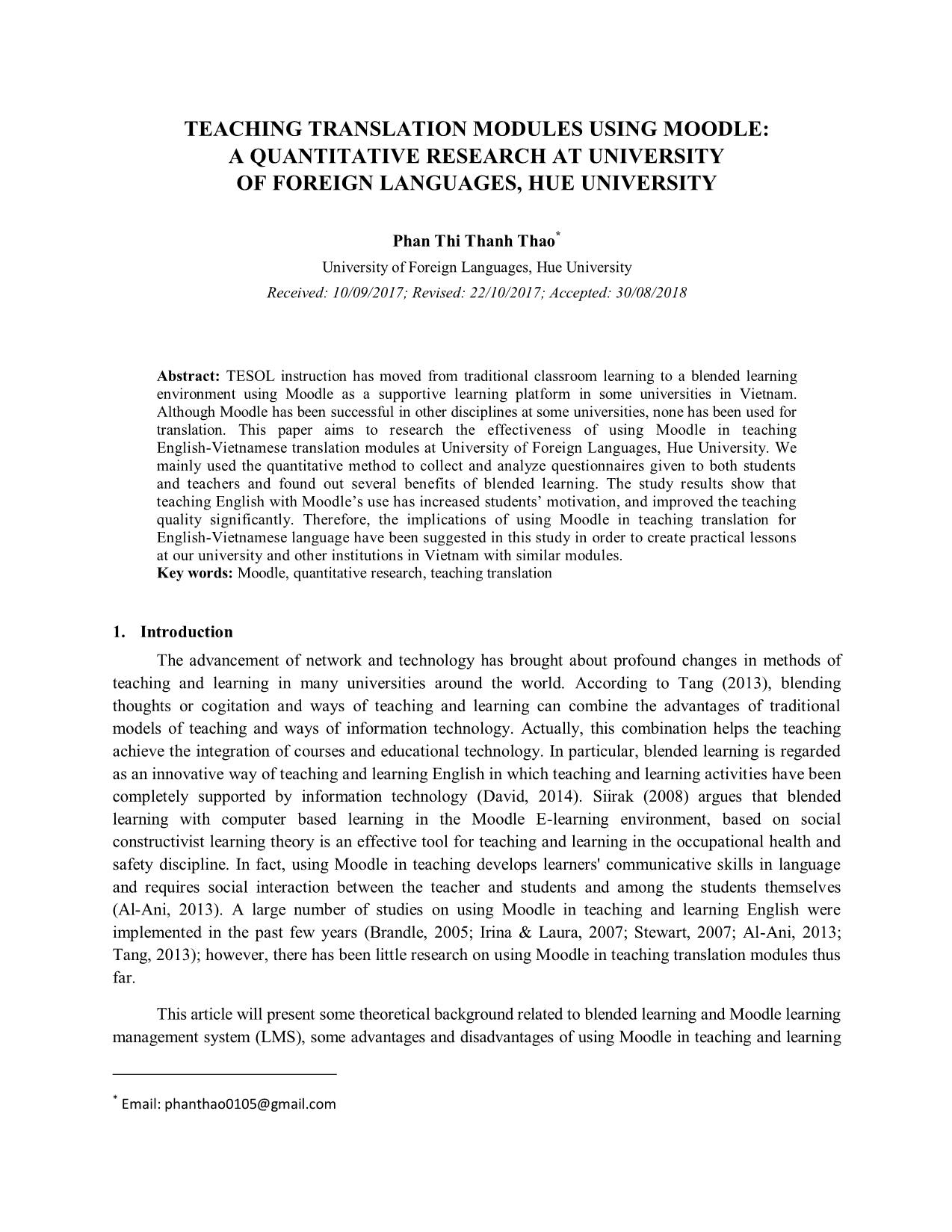
Trang 1
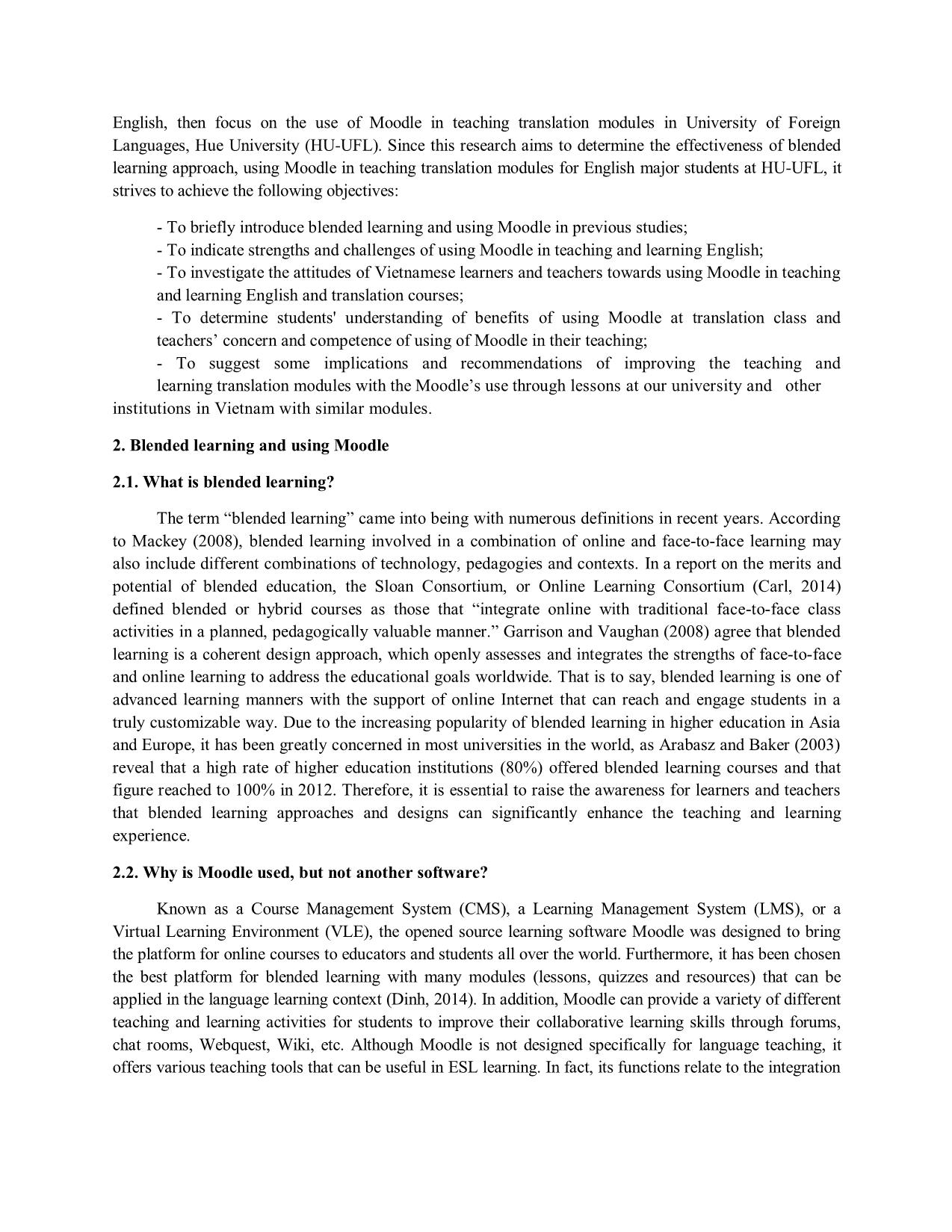
Trang 2
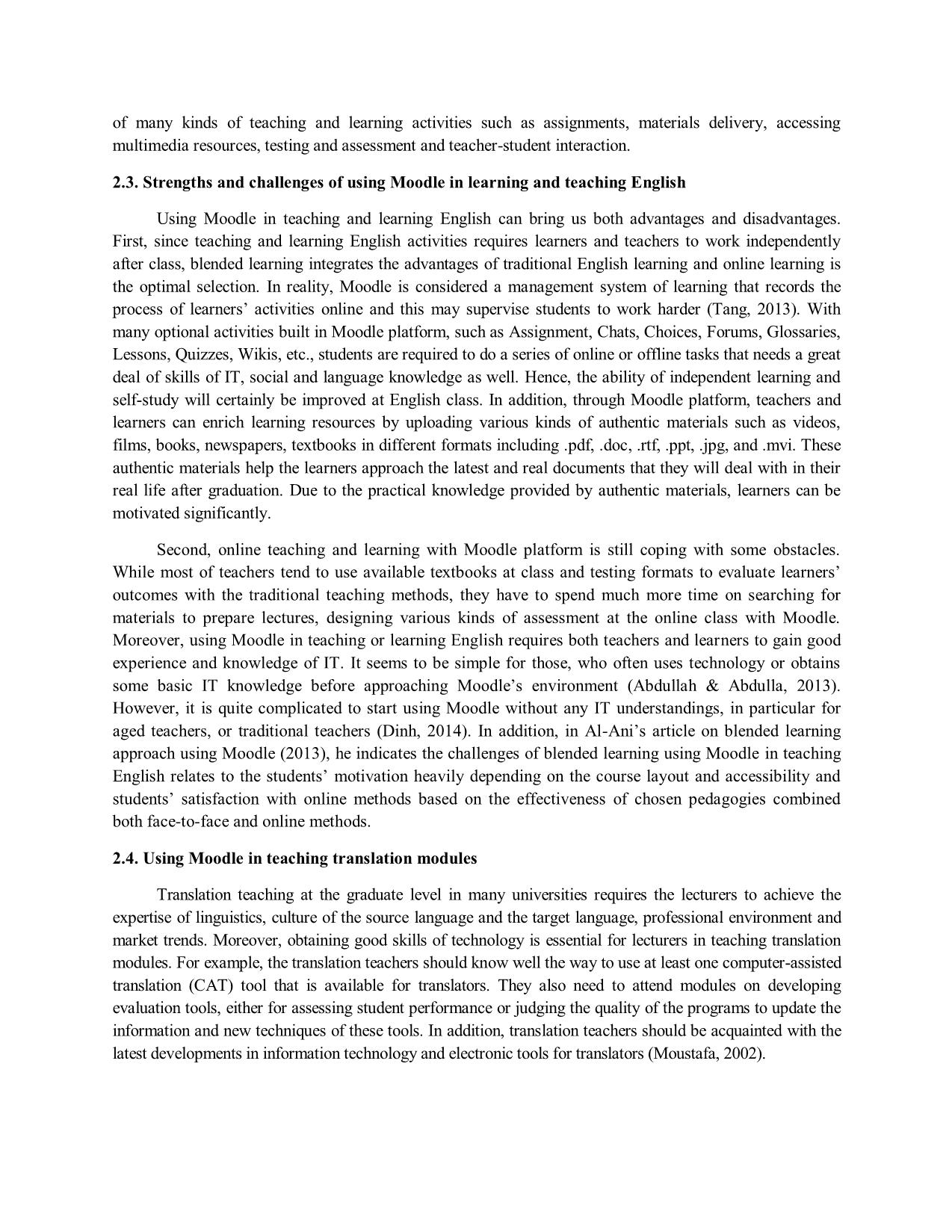
Trang 3
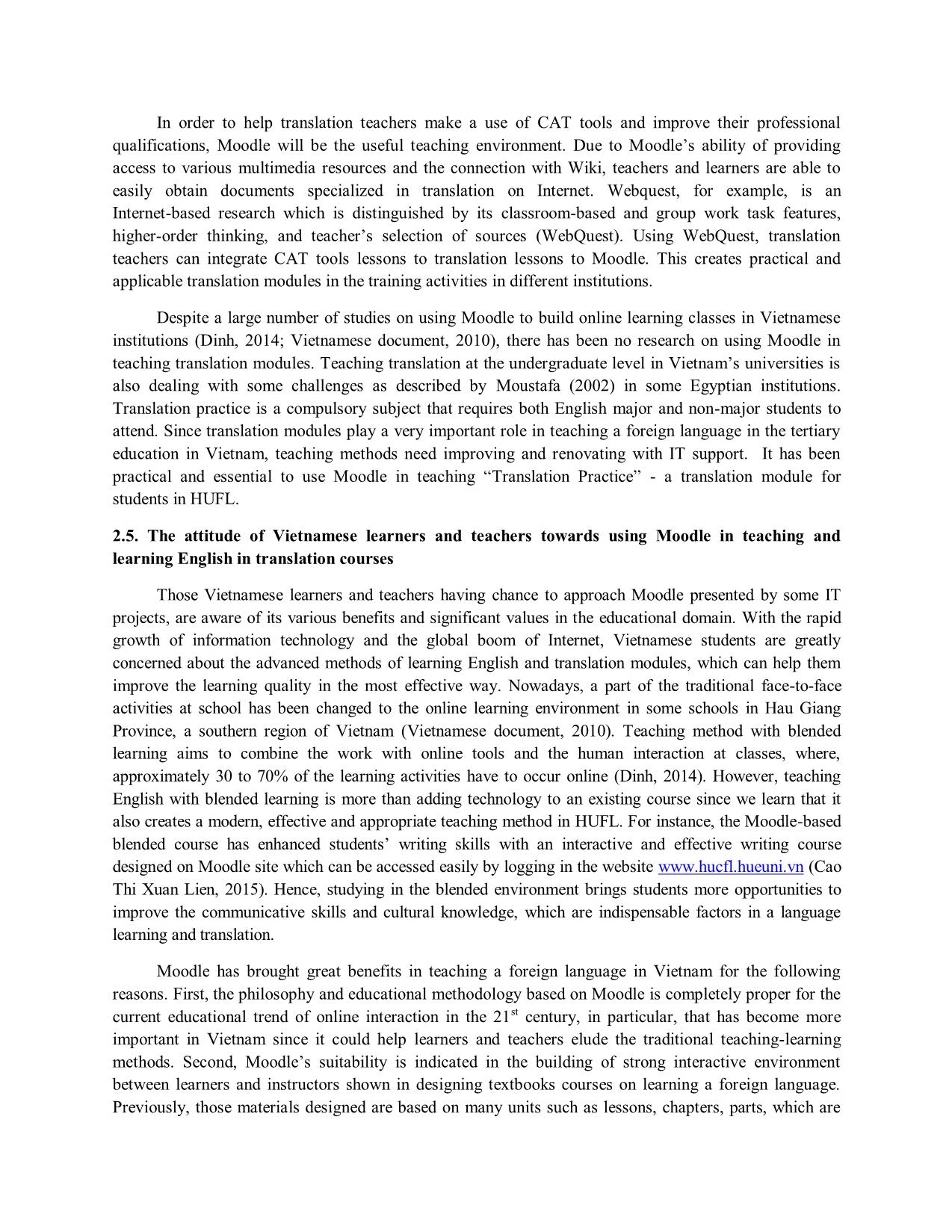
Trang 4

Trang 5
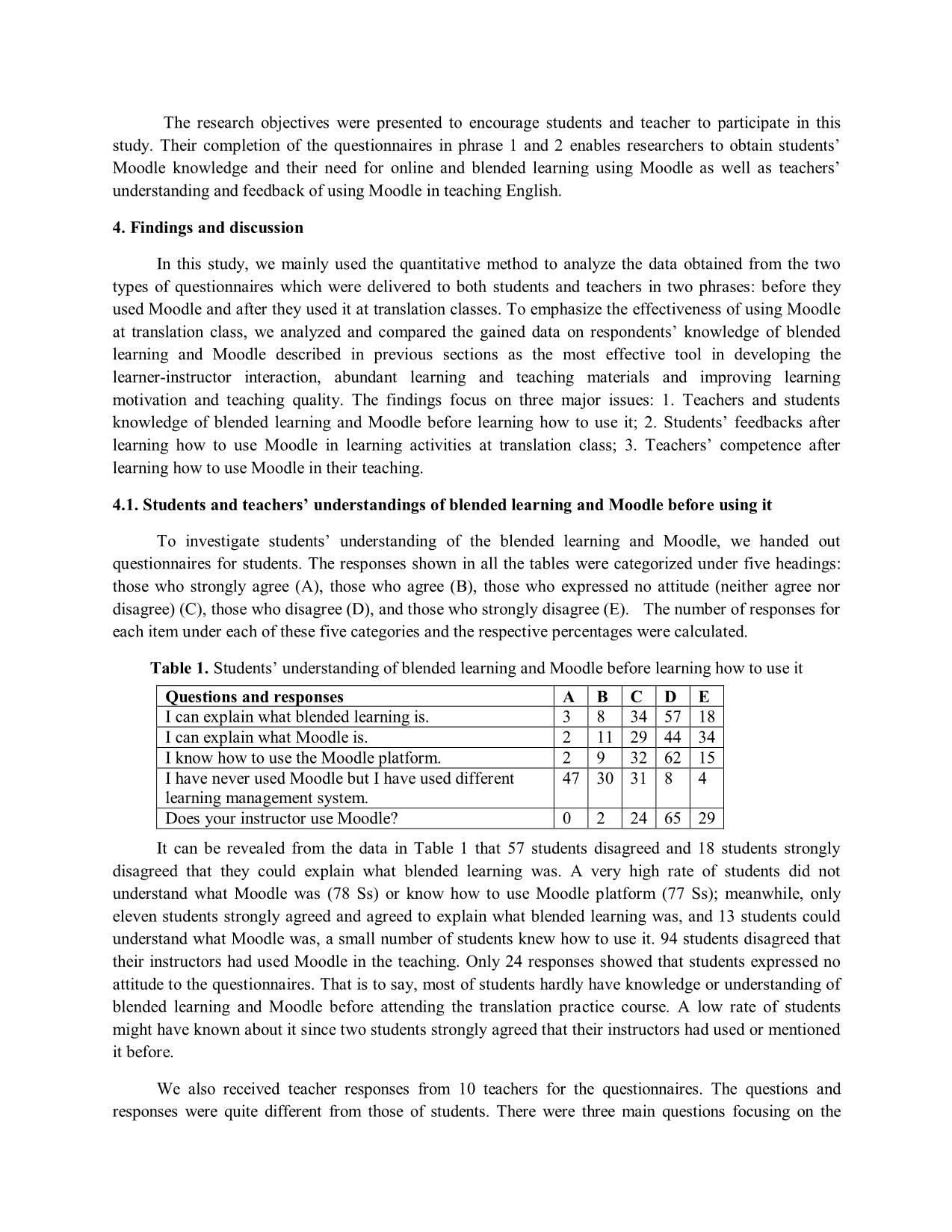
Trang 6
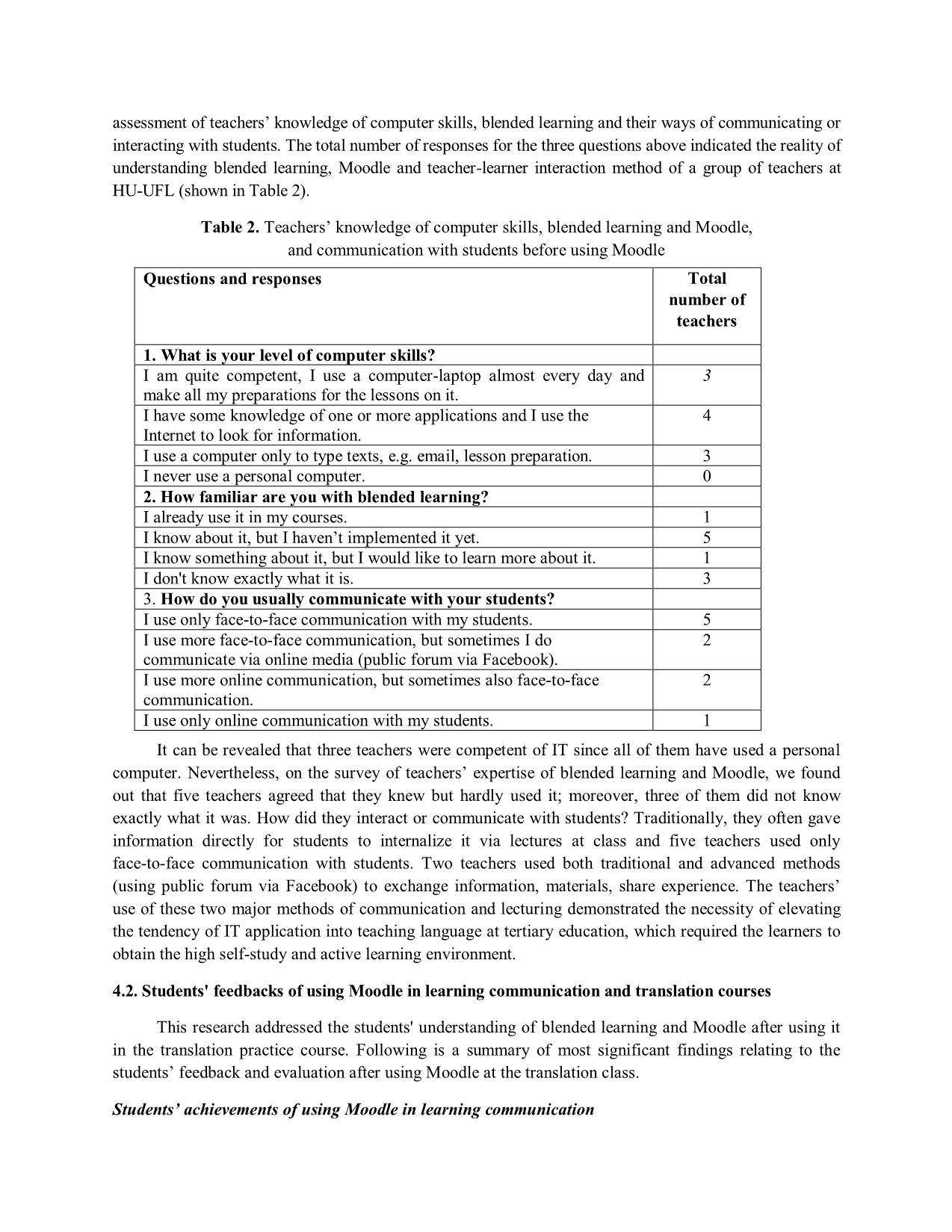
Trang 7

Trang 8
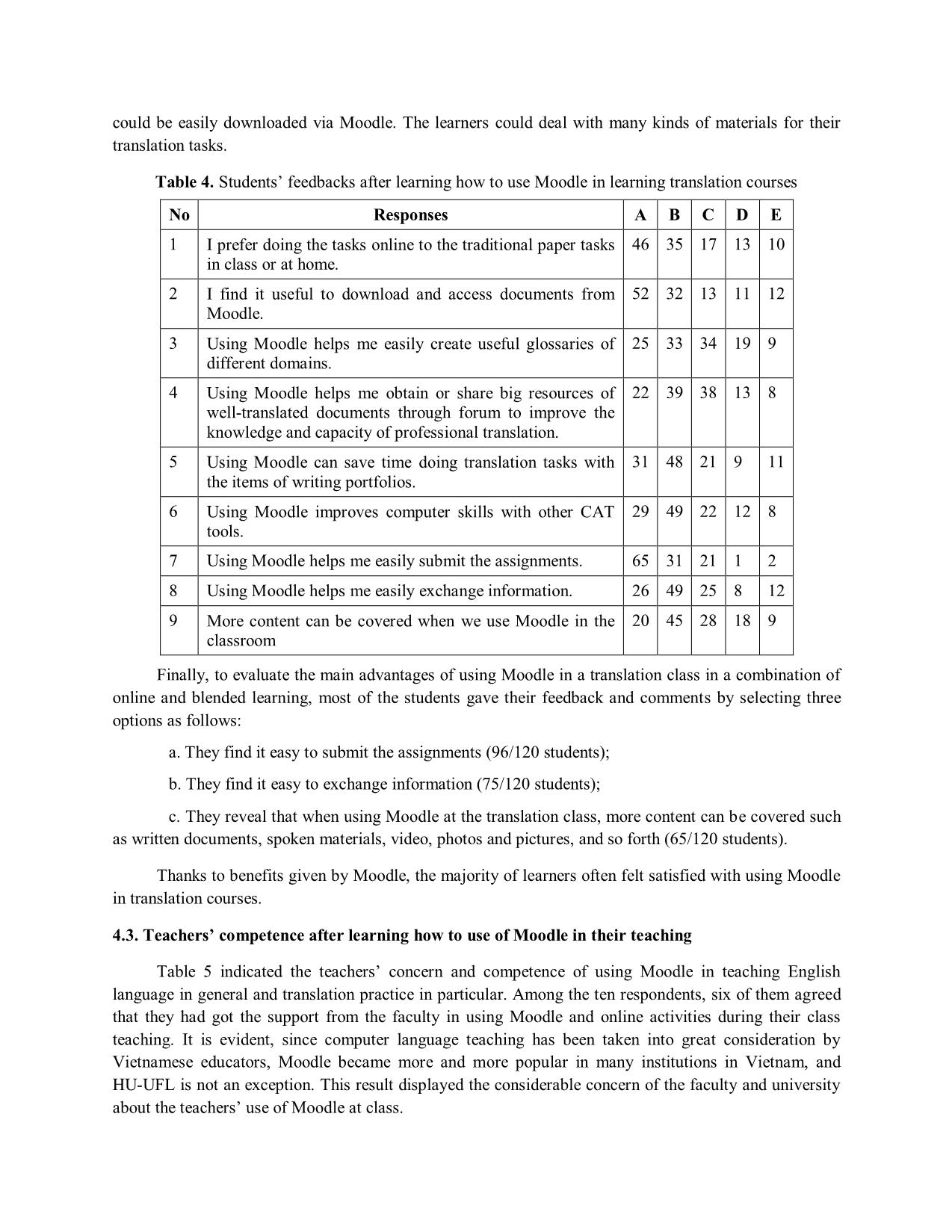
Trang 9
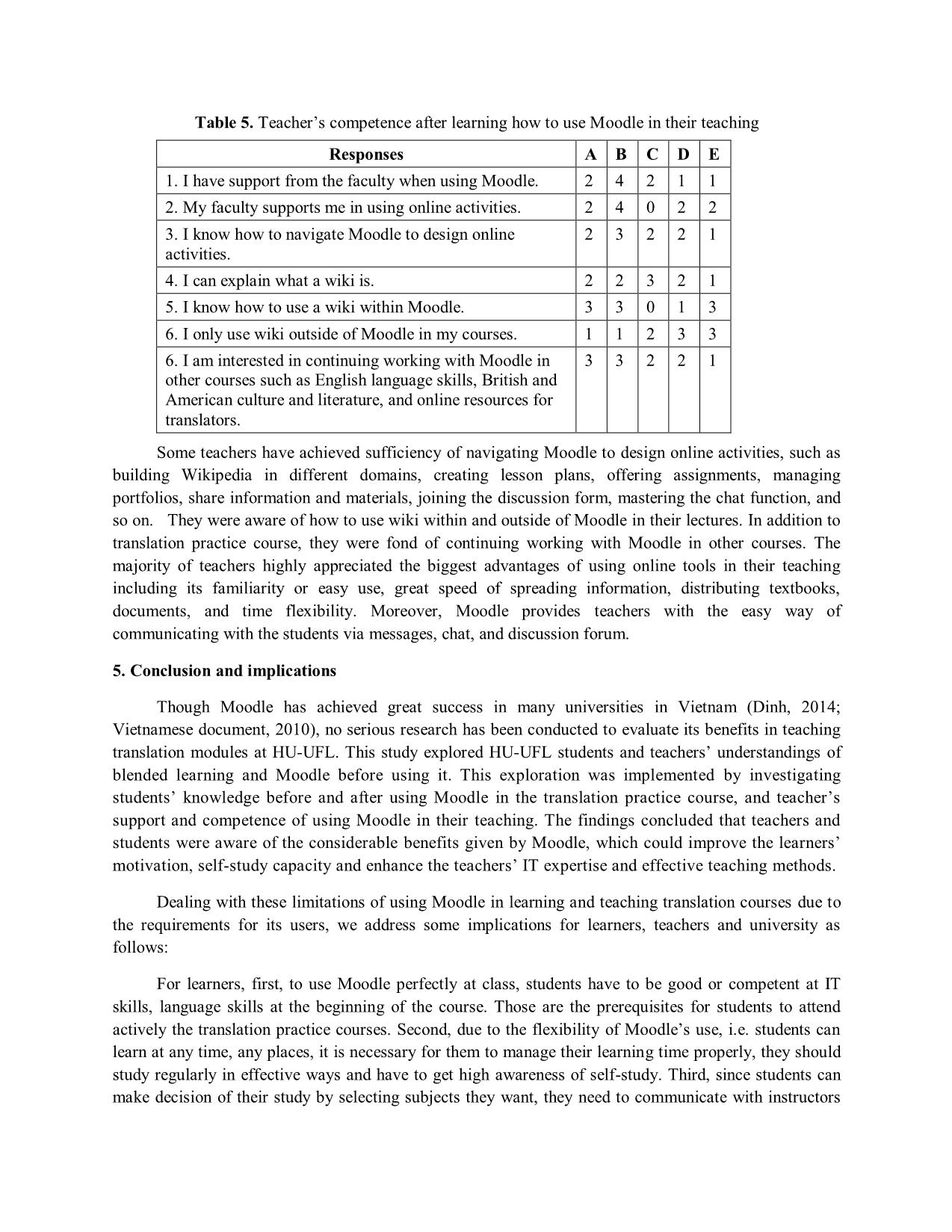
Trang 10
Tải về để xem bản đầy đủ
Tóm tắt nội dung tài liệu: Teaching translation modules using moodle: A quantitative research at university of foreign languages, Hue university

TEACHING TRANSLATION MODULES USING MOODLE: A QUANTITATIVE RESEARCH AT UNIVERSITY OF FOREIGN LANGUAGES, HUE UNIVERSITY Phan Thi Thanh Thao * University of Foreign Languages, Hue University Received: 10/09/2017; Revised: 22/10/2017; Accepted: 30/08/2018 Abstract: TESOL instruction has moved from traditional classroom learning to a blended learning environment using Moodle as a supportive learning platform in some universities in Vietnam. Although Moodle has been successful in other disciplines at some universities, none has been used for translation. This paper aims to research the effectiveness of using Moodle in teaching English-Vietnamese translation modules at University of Foreign Languages, Hue University. We mainly used the quantitative method to collect and analyze questionnaires given to both students and teachers and found out several benefits of blended learning. The study results show that teaching English with Moodle’s use has increased students’ motivation, and improved the teaching quality significantly. Therefore, the implications of using Moodle in teaching translation for English-Vietnamese language have been suggested in this study in order to create practical lessons at our university and other institutions in Vietnam with similar modules. Key words: Moodle, quantitative research, teaching translation 1. Introduction The advancement of network and technology has brought about profound changes in methods of teaching and learning in many universities around the world. According to Tang (2013), blending thoughts or cogitation and ways of teaching and learning can combine the advantages of traditional models of teaching and ways of information technology. Actually, this combination helps the teaching achieve the integration of courses and educational technology. In particular, blended learning is regarded as an innovative way of teaching and learning English in which teaching and learning activities have been completely supported by information technology (David, 2014). Siirak (2008) argues that blended learning with computer based learning in the Moodle E-learning environment, based on social constructivist learning theory is an effective tool for teaching and learning in the occupational health and safety discipline. In fact, using Moodle in teaching develops learners' communicative skills in language and requires social interaction between the teacher and students and among the students themselves (Al-Ani, 2013). A large number of studies on using Moodle in teaching and learning English were implemented in the past few years (Brandle, 2005; Irina & Laura, 2007; Stewart, 2007; Al-Ani, 2013; Tang, 2013); however, there has been little research on using Moodle in teaching translation modules thus far. This article will present some theoretical background related to blended learning and Moodle learning management system (LMS), some advantages and disadvantages of using Moodle in teaching and learning * Email: phanthao0105@gmail.com English, then focus on the use of Moodle in teaching translation modules in University of Foreign Languages, Hue University (HU-UFL). Since this research aims to determine the effectiveness of blended learning approach, using Moodle in teaching translation modules for English major students at HU-UFL, it strives to achieve the following objectives: - To briefly introduce blended learning and using Moodle in previous studies; - To indicate strengths and challenges of using Moodle in teaching and learning English; - To investigate the attitudes of Vietnamese learners and teachers towards using Moodle in teaching and learning English and translation courses; - To determine students' understanding of benefits of using Moodle at translation class and teachers’ concern and competence of using of Moodle in their teaching; - To suggest some implications and recommendations of improving the teaching and learning translation modules with the Moodle’s use through lessons at our university and other institutions in Vietnam with similar modules. 2. Blended learning and using Moodle 2.1. What is blended learning? The term “blended learning” came into being with numerous definitions in recent years. According to Mackey (2008), blended learning involved in a combination of online and face-to-face learning may also include different combinations of technology, pedagogies and contexts. In a report on the merits and potential of blended education, the Sloan Consortium, or Online Learning Consortium (Carl, 2014) defined blended or hybrid courses as those that “integrate online with traditional face-to-face class activities in a planned, pedagogically valuable manner.” Garrison and Vaughan (2008) agree that blended learning is a coherent design approach, which openly assesses and integrates the strengths of face-to-face and online learning to address the educational goa ... r. Nevertheless, on the survey of teachers’ expertise of blended learning and Moodle, we found out that five teachers agreed that they knew but hardly used it; moreover, three of them did not know exactly what it was. How did they interact or communicate with students? Traditionally, they often gave information directly for students to internalize it via lectures at class and five teachers used only face-to-face communication with students. Two teachers used both traditional and advanced methods (using public forum via Facebook) to exchange information, materials, share experience. The teachers’ use of these two major methods of communication and lecturing demonstrated the necessity of elevating the tendency of IT application into teaching language at tertiary education, which required the learners to obtain the high self-study and active learning environment. 4.2. Students' feedbacks of using Moodle in learning communication and translation courses This research addressed the students' understanding of blended learning and Moodle after using it in the translation practice course. Following is a summary of most significant findings relating to the students’ feedback and evaluation after using Moodle at the translation class. Students’ achievements of using Moodle in learning communication Table 3 below showed the students’ capacity of navigating Moodle and using it in communicating with teachers and other students at translation classes. 46 students agreed that they found Moodle easy to navigate, 13 students had some technical difficulties using Moodle in learning English. 22 students strongly agreed and 30 students agreed to use Moodle to communicate with teachers and other students via email and sometimes through discussion forum. Furthermore, most of students (42 Ss strongly agreed and 38 Ss agreed) preferred online discussion to classroom discussion since Moodle is helpful for keeping track of discussion. In a big class, there were not any chances to make face-to-face discussion at all. Therefore, online discussion was the most effective way to raise questions and receive responses from all the members in the course. Table 3. Students’ feedbacks after learning how to use Moodle in learning communication N o Responses A B C D E 1 I find Moodle easy to navigate. 3 5 4 6 1 5 1 4 1 0 2 I have some technical difficulties using Moodle. 1 4 1 3 2 0 4 6 2 7 3 I often use Moodle to communicate with teachers and other students via email or discussion forum. 2 2 3 0 2 8 3 4 6 4 I prefer online discussion to classroom discussion. 4 2 3 8 2 3 1 5 2 As to learning activities using Moodle at translation class, we found out some results as shown in Table 4 below. We find out that 46 students agreed and 35 strongly agreed that they preferred doing the task online to the traditional paper tasks in class or at home, since they found Moodle useful and convenient to help them complete their tasks in their own time and right place. According to many students’ comments, they could spend less time typing and translating the texts from English into Vietnamese and vice versa with personal computer instead of translating texts by hand-writing. What is more, 31 students strongly agreed and 48 students agreed that using Moodle could save them time to prepare and complete translation tasks in translation lessons with the item of writing portfolios. That is to say, time and place flexibility is one of the Moodle’s strengths in learning activities. Working with Moodle in translation module 1 for about 15 weeks, students’ expertise and method of professional translation could be enhanced to some extent. Specifically, using Moodle helped the majority of students easily create useful glossaries of different domains such as education, health, economics, environment, which could support students in translation and interpretation tasks. Moreover, 62 students strongly agreed and agreed that using Moodle supported them in obtaining or sharing large amount of resources of well-translated documents through forum to improve the knowledge and expertise of professional translation. As a result, learners explained that they could achieve more independence and self-directed learning and high learning motivation through using Moodle in translation class. Concerning the learners’ development of computer skills, 78 students confirmed that using Moodle improves their computer skills through practice translation tasks with Computer-assisted translation tools such as Wordfast, SDL Trados, and Omega T. Since it was fast and flexible to download and access documents from Moodle, a variety of documents in different format (.pdf, .doc, .txt, .html, .ppt, .jpg, etc.) could be easily downloaded via Moodle. The learners could deal with many kinds of materials for their translation tasks. Table 4. Students’ feedbacks after learning how to use Moodle in learning translation courses No Responses A B C D E 1 I prefer doing the tasks online to the traditional paper tasks in class or at home. 46 35 17 13 10 2 I find it useful to download and access documents from Moodle. 52 32 13 11 12 3 Using Moodle helps me easily create useful glossaries of different domains. 25 33 34 19 9 4 Using Moodle helps me obtain or share big resources of well-translated documents through forum to improve the knowledge and capacity of professional translation. 22 39 38 13 8 5 Using Moodle can save time doing translation tasks with the items of writing portfolios. 31 48 21 9 11 6 Using Moodle improves computer skills with other CAT tools. 29 49 22 12 8 7 Using Moodle helps me easily submit the assignments. 65 31 21 1 2 8 Using Moodle helps me easily exchange information. 26 49 25 8 12 9 More content can be covered when we use Moodle in the classroom 20 45 28 18 9 Finally, to evaluate the main advantages of using Moodle in a translation class in a combination of online and blended learning, most of the students gave their feedback and comments by selecting three options as follows: a. They find it easy to submit the assignments (96/120 students); b. They find it easy to exchange information (75/120 students); c. They reveal that when using Moodle at the translation class, more content can be covered such as written documents, spoken materials, video, photos and pictures, and so forth (65/120 students). Thanks to benefits given by Moodle, the majority of learners often felt satisfied with using Moodle in translation courses. 4.3. Teachers’ competence after learning how to use of Moodle in their teaching Table 5 indicated the teachers’ concern and competence of using Moodle in teaching English language in general and translation practice in particular. Among the ten respondents, six of them agreed that they had got the support from the faculty in using Moodle and online activities during their class teaching. It is evident, since computer language teaching has been taken into great consideration by Vietnamese educators, Moodle became more and more popular in many institutions in Vietnam, and HU-UFL is not an exception. This result displayed the considerable concern of the faculty and university about the teachers’ use of Moodle at class. Table 5. Teacher’s competence after learning how to use Moodle in their teaching Responses A B C D E 1. I have support from the faculty when using Moodle. 2 4 2 1 1 2. My faculty supports me in using online activities. 2 4 0 2 2 3. I know how to navigate Moodle to design online activities. 2 3 2 2 1 4. I can explain what a wiki is. 2 2 3 2 1 5. I know how to use a wiki within Moodle. 3 3 0 1 3 6. I only use wiki outside of Moodle in my courses. 1 1 2 3 3 6. I am interested in continuing working with Moodle in other courses such as English language skills, British and American culture and literature, and online resources for translators. 3 3 2 2 1 Some teachers have achieved sufficiency of navigating Moodle to design online activities, such as building Wikipedia in different domains, creating lesson plans, offering assignments, managing portfolios, share information and materials, joining the discussion form, mastering the chat function, and so on. They were aware of how to use wiki within and outside of Moodle in their lectures. In addition to translation practice course, they were fond of continuing working with Moodle in other courses. The majority of teachers highly appreciated the biggest advantages of using online tools in their teaching including its familiarity or easy use, great speed of spreading information, distributing textbooks, documents, and time flexibility. Moreover, Moodle provides teachers with the easy way of communicating with the students via messages, chat, and discussion forum. 5. Conclusion and implications Though Moodle has achieved great success in many universities in Vietnam (Dinh, 2014; Vietnamese document, 2010), no serious research has been conducted to evaluate its benefits in teaching translation modules at HU-UFL. This study explored HU-UFL students and teachers’ understandings of blended learning and Moodle before using it. This exploration was implemented by investigating students’ knowledge before and after using Moodle in the translation practice course, and teacher’s support and competence of using Moodle in their teaching. The findings concluded that teachers and students were aware of the considerable benefits given by Moodle, which could improve the learners’ motivation, self-study capacity and enhance the teachers’ IT expertise and effective teaching methods. Dealing with these limitations of using Moodle in learning and teaching translation courses due to the requirements for its users, we address some implications for learners, teachers and university as follows: For learners, first, to use Moodle perfectly at class, students have to be good or competent at IT skills, language skills at the beginning of the course. Those are the prerequisites for students to attend actively the translation practice courses. Second, due to the flexibility of Moodle’s use, i.e. students can learn at any time, any places, it is necessary for them to manage their learning time properly, they should study regularly in effective ways and have to get high awareness of self-study. Third, since students can make decision of their study by selecting subjects they want, they need to communicate with instructors or other classmates for their right and useful advice through chat or discussion forum. In some cases, they had better communicate directly with the teachers and friends because of technical errors of online activities. For teachers, they are required to have good IT skills to work with advanced technology facilities that support and diversify their teaching techniques and method. Translation teachers also need to receive training on CAT tools that play a vital role in giving translation course to meet current jobs’ needs in the market. Therefore, they should be acquainted with the latest development in information technology and electronic tools for translators. Without satisfying these requirements, translation teachers will not be able to do their job effectively. Finally, they have to select the appropriate teaching methods that depend on other factors including classroom facilities, available equipment, availability of time, and above all the skills of the teacher in using these resources. For universities, due to the high cost of facilities such as classrooms that are required to be well-equipped and computers with high-speed and stable connection, the institution should spend large amounts of money on high-quality equipment and infrastructure facilities. It is also essential to train high-qualified teaching staff with good expertise in order to provide effective courses that can satisfy students’ needs for knowledge and skills and come up to their expectations. References Abdullah, C., & Abdulla, A. (2013). Moodling English language education. Education, 3(134), 275-281. Al-Ani, W. (2013). Blended learning approach using Moodle and student’s achievement at Sultan Qaboos University in Oman. Journal of Education and Learning, 2(3), 96-110. Arabsz, P., & Baker, M.B. (2003). Evolving campus support models for E-learning courses. Educause Center for Applied Research Bulletin. Retrieved from /ers/ERS0303 /EKF0303.pdf. Brandle, K. (2005). Are you ready to Moodle?. Language Learning Technology, 9(2), 16-23. Cao Thị Xuân Liên (2015). Enhancing writing skills for second-year English majors through a Moodle-based blended writing course: an action research at University of Foreign Languages, Hue University. Retrieved from /Ms.%20Cao%20Thi%20Xuan%20Lien.pdf. Carl, S. (2014). Sloan goes online. Retrieved from https://www.insidehighered.com/news /2014/07/07/sloan-consortium-renames-itself-onlinE-learning-consortium. Dinh, L.G. (2014). Từ Moodle đến HTĐT đối với việc giảng dạy ngoại ngữ trực tuyến ở Việt Nam (Moodle in training activities of online teaching foreign languages in Vietnam). Retrieved from Garrison, D.R., & Vaughan, N.D. (2008). Blended learning in higher education: frameworks, principles and guidelines. San Francisco, CA: Jossey-Bass. Mackey, J. (2008). Blending real work experiences and virtual professional development. In Hello! Where are you in the landscape of educational technology?. Proceedings Ascilite Melbourne 2008. Moustafa, G. (2002). A skeleton in the closet: teaching translation in Egyptian National Universities. Translation Journal, 6(1). Retrieved from Siirak, V. (2008). Moodle E-learning environment: an effective tool for a development of a learning culture. Institution of Chemical Engineers Symposium Series, 154, 290-296. Stewart, B. et al. (2007). Choosing Moodle: an evaluation of learning management systems at Athabasca University. International Journal of Distance Education Technologies (IJDET), 5(3), 1-7. Tang, J. (2013). The research on blended learning of ESL based on Moodle platform. Studies in Literature and Language, 6(2), 30-34. David, H. (2014). Teaching English studies through blended learning. Retrieved from https://www.heacademy.ac.uk/sites/default/files/resources/Teaching_English_studies_throug h_blended_learning.pdf Irina, A. A., & Laura, P. G. (2007). Blended-learning in ESP: An insight in Moodle. Villanueva de laCañada (Madrid) Vietnamese document (2010). Tài liệu tập huấn sử dụng Moodle tạo lớp học trực tuyến. Retrieved from www.academia.edu/9198709/Tài_liệu_tập_huấn_sử_dụng_Moodle _tạo_lớp_học_trực_tuyến _tháng_8_năm_2010 _Tài_liệu_tập_huấn WebQuest (2015).
File đính kèm:
 teaching_translation_modules_using_moodle_a_quantitative_res.pdf
teaching_translation_modules_using_moodle_a_quantitative_res.pdf

